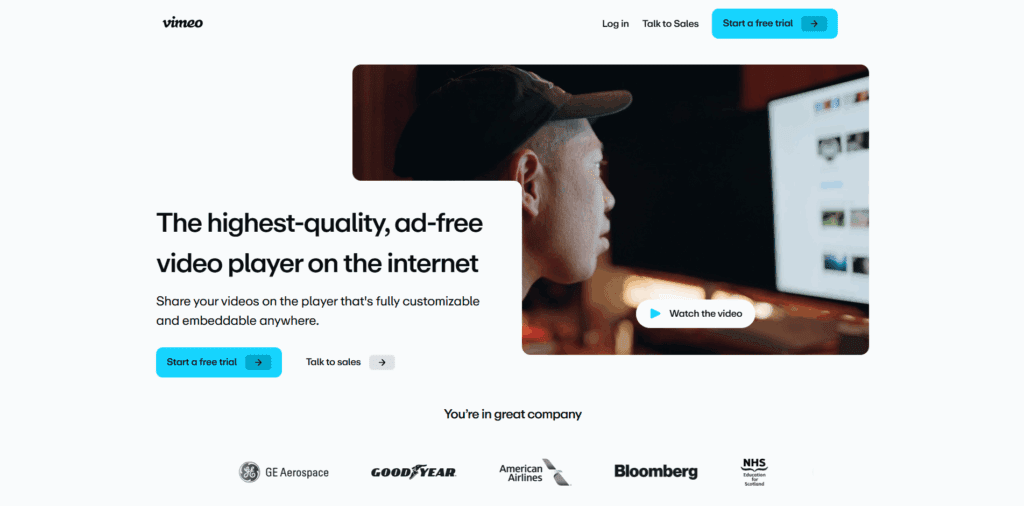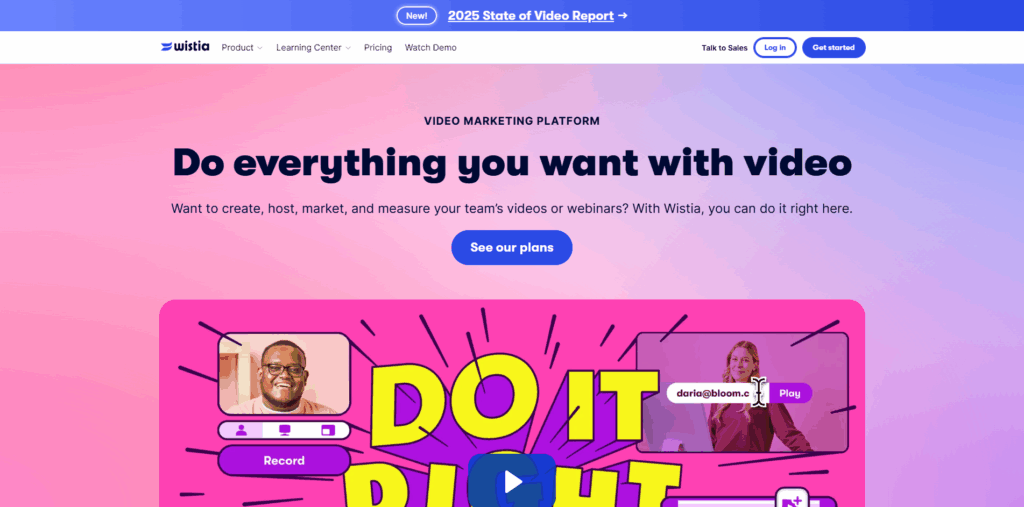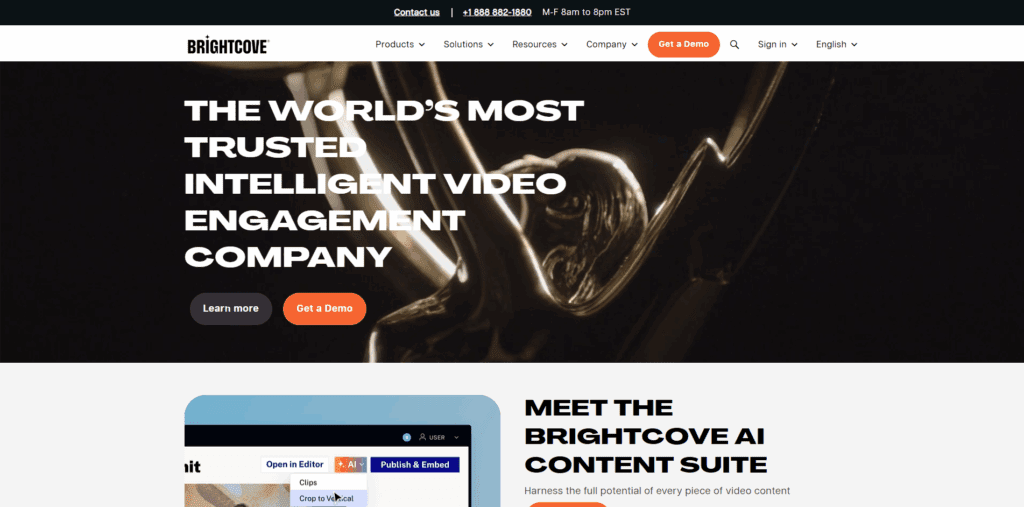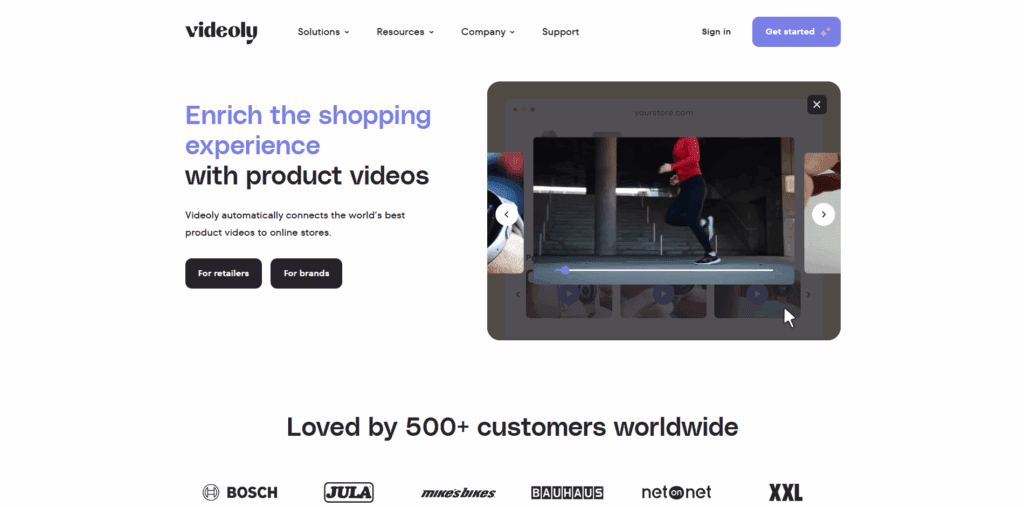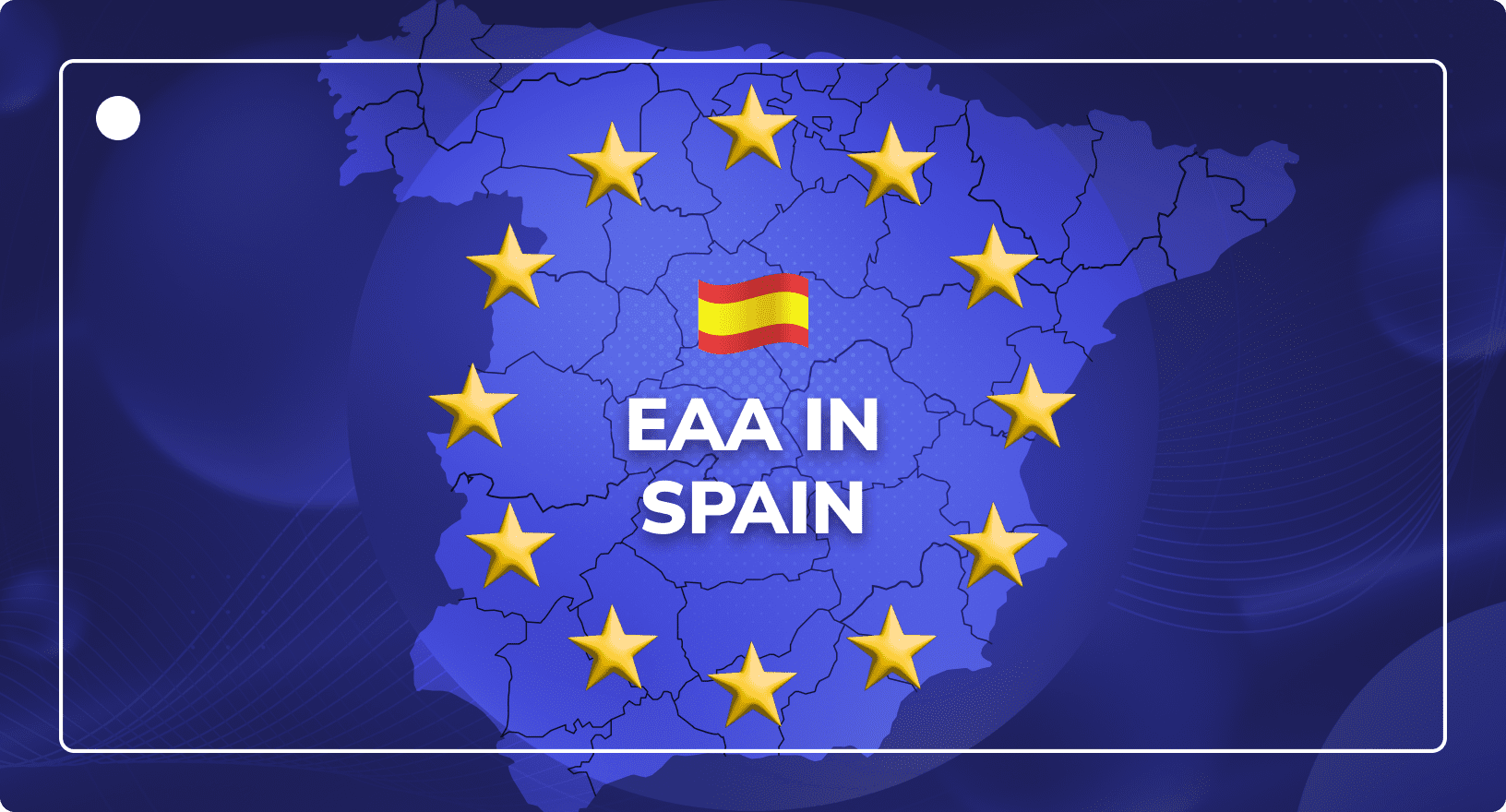YouTube Alternatives for E-Tailers: How to Replace YouTube and Increase Conversions
Content Syndication
Updated on June 20, 2025
Looking for better ways to host and display product videos without YouTube distractions, ads, or compliance headaches? You’re not alone.
E-tailers are increasingly searching for YouTube alternatives that offer complete control, better video quality, accessibility, and higher conversion rates.
Whether you’re a Head of E-Commerce, a Digital Manager, or a Marketing Director, you need a video hosting platform built for your KPIs, not cat videos.
This guide explores the best YouTube alternatives for retail e-commerce, why YouTube may be hurting your sales, and how video platforms like DemoUp Cliplister can help you achieve scale, compliance, and performance without the compromises.
Along the way, we’ll unpack essential evaluation criteria, address common objections, and provide real-world examples of how other solutions like content syndication platforms can directly improve your bottom line.

Learn How POWER Automated Video & 3D Content Curation
Free DownloadWhy YouTube Falls Short
YouTube is a great place for watching videos, product discovery and influencer content. But for product videos embedded on your retail e-commerce site, it comes with serious drawbacks that can damage your customer experience and profitability.
Here are the top four reasons why many online shops turn to YouTube alternatives for video hosting:
1. Poor Quality, Irrelevant Content
Most brands only control the videos available on their official YouTube channel (if they even have one). That means:
- Low-res, shaky user-generated videos that may misrepresent your product, potentially showing it out of context, incomplete, or being used incorrectly.
- No product context or store branding, making it hard for customers to trust the source or connect the video with your brand promise.
- Ads for your competitors that appear before, during, or after your product video effectively hand off your customer to someone else.
As a result, customers are left confused or underwhelmed. These issues directly impact video quality, degrade your customer experience, and undercut your efforts to increase conversions.
In a world where 84% of consumers say they’ve been convinced to buy something after watching a product video, subpar content is no longer acceptable, and neither is driving them to other platforms.
2. User Bounce and Ad Distractions
Like YouTube-native videos, embedded YouTube players are designed to keep users on engaging with YouTube’s content, not necessarily on your site.
After a video ends, viewers are often shown “related” videos, which may have nothing to do with your products.
Worse, they might link to your competitors or feature content that undermines your product’s perceived value.
3. AutoPlay
YouTube’s autoplay feature alone can pull attention away from your page in a matter of seconds. At the end of every video, YouTube displays This encourages users to click away, interrupting the buying journey and harming your conversion rates. E-commerce is all about reducing friction, and YouTube introduces more of it than it removes.
4. Compliance Burdens (EAA)
To comply with the European Accessibility Act, retailers must ensure that all digital content, including video, is accessible. That includes:
- Providing accurate audio descriptions for visually impaired users, so that they can receive key visual information audibly.
- Including captioning for hearing-impaired audiences, which improves usability across a broad customer base.
- Ensuring full keyboard navigation and screen reader compatibility, crucial for accessible shopping experiences.
YouTube offers some tools for this, but everything needs to be done manually. For retailers with hundreds or thousands of videos, this becomes an enormous operational burden. It introduces compliance risk and takes your team’s focus away from core growth activities.
Worse yet, non-compliance can result in legal exposure, brand damage, and the alienation of important customer segments.nline shops regardless of the platform or CMS it uses.
To see what complaint video players look like in practice, here is DemoUp Cliplister’s video accessibility solution:
The Case for Alternatives
Retailers need more than just video playback. They need comprehensive video sharing platforms that:
- Embed high-quality video directly on product pages with minimal load times, optimised for mobile and desktop viewing.
- Is completely ad free, keeping customers focused on your products rather than wandering off to unrelated or even harmful content.
- Automates EAA compliance so you’re legally protected, inclusive, and able to serve all potential customers.
- Offers advanced analytics that connect video engagement to KPIs like add-to-cart rate, conversion rate, average order value (AOV), and even return rate reduction.
- Seamlessly integrates with your existing tech stack, including PIM systems, CMS platforms, and e-commerce backends like Shopify, Magento, and Salesforce Commerce Cloud.
In short, retailers need ad free video platforms that act like revenue accelerators, not distractions.
Best YouTube Alternatives for E-Commerce Retailers
Here’s a deep dive into the best alternatives to YouTube for e-commerce retailers:
1. DemoUp Cliplister
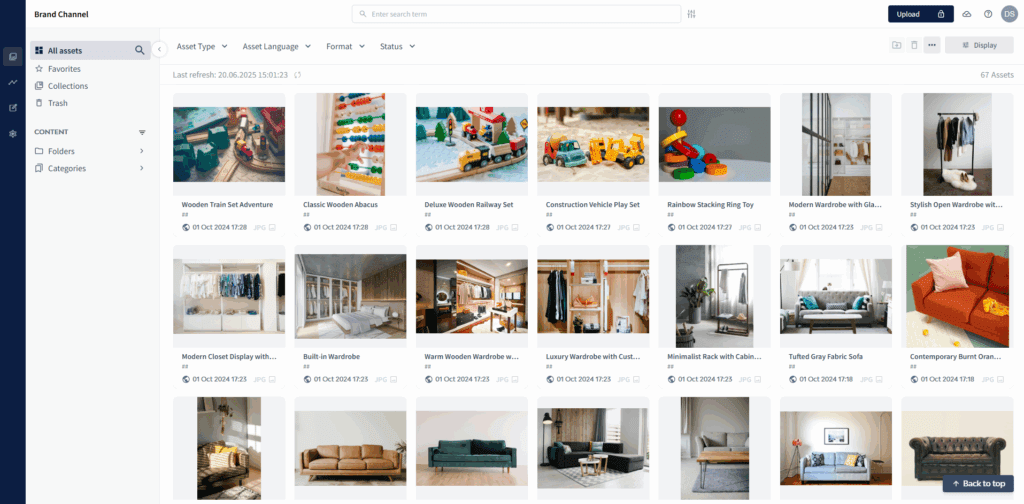
A dedicated video syndication platform built specifically for retailers, DemoUp Cliplister is the ideal YouTube alternative for enterprise and mid-sized e-commerce companies.
With DemoUp Cliplister, you get:
- Instant access to over 300,000 high-quality product videos from leading global brands, including Bosch, Samsung, Kärcher, and many others. Instead of chasing content or relying on low-quality YouTube uploads, retailers can fill product pages with engaging, professional video in just a few clicks.
- Exceptional video quality thanks to direct sourcing from brand manufacturers. This ensures every asset is professionally produced, up-to-date, and on-brand. Videos are automatically encoded for fast loading, mobile repsonsiveness, and crisp resolution across all devices.
- Automatic EAA compliance with an accessible video player that includes keyboard navigation, captions, and optional audio descriptions all handled automatically at scale.
- A completely ad-free viewing experience, so customers stay focused on your products, not distracted by YouTube content or competitor promotions.
- Support for advanced formats like 3D models and AR experiences, seamlessly integrated into your product pages for maximum engagement and interactivity.
- Built-in video analytics that help you understand how video content impacts your sales funnel from impressions to conversions. You’ll know exactly which videos contribute to revenue, and which need optimising.
“We integrated thousands of product assets from important brands quickly and efficiently into our PDPs. The integration is simple and completed in a matter of minutes. They event customised the video thumbnails for us.”
— Maxime Chapsal, Head of Business Projects, Rue du Commerce
Unlike YouTube and many other video platforms, DemoUp Cliplister operates as a video and content syndication network, giving you high-grade video quality with zero friction.
The result is a retail-ready content sourcing platform and compelling alternative to YouTube that scales with your product assortment and organisational needs.
Here are other key features that differentiate DemoUp Cliplister from other video platforms like YouTube:
- Easy Site-Wide Integration: The only work you need to do with DemoUp Cliplister is copy a few lines of code into your online shop’s template. When this is complete you have product videos on your PDPs in a matter of minutes.
- 3D and AR Models: With DemoUp Cliplister, you can also display 3D product models and AR experiences in your product galleries.
- Better SEO: DemoUp Cliplister’s content displays in a native video player that loads 300% faster than YouTube’s. This results in better customer experience and more sales.
- Customers Stay in Your Shop: The absolute biggest complaint we hear from clients who switch away from YouTube is that it distracts customers. YouTube is designed to keep people inside its ecosystem, and as such, displays videos it thinks users would like to keep them engaged.
- GDPR Compliance: YouTube requires the use of cookies to load media in your shop. This requires you to acquire consent from your shoppers before you can display videos.
- Simple Video Sharing: Every video uploaded to DemoUp Cliplister gets a unique link that can be shared with all your stakeholders.

2. Vimeo
Vimeo has carved out a niche as possibly YouTube’s biggest competitor. As far as YouTube alternatives go, it features a clean interface, strong tools for video creators, and a commitment to being an ad-free video platform.
Pros:
- Clean, professional interface with a better user experience compared to YouTube
- Support for HD and 4K video ensures excellent video quality
- Basic video analytics help track views and engagement
- Offers password protection and privacy controls for gated content or internal training use cases
Cons:
- Manual upload and tagging required for each video with no ability to tap into brand libraries or shared repositories
- No built-in syndication tools for populating large product catalogues
- No accessibility automation or built-in compliance features
In summary, Vimeo is a respectable online video platform, but it’s better suited to small-scale content marketing and portfolio pieces than full-scale e-commerce operations.
3. Wistia
Wistia is a go-to for content marketers who want granular control and deep CRM integrations. It’s excellent for webinars, gated videos, and B2B explainer content.
Pros:
- Fully customisable video player, allowing for brand-consistent video design
- Integration with major CRMs and automation tools to track views, trigger emails, score leads
- Interactive elements like calls-to-action, forms, and annotations encourage engagement
Cons:
- Lacks syndicated video content — every video must be created or sourced manually
- Not optimised for product page performance or retail conversion flows
- Accessibility tools are minimal and require manual implementation
Retailers looking for a performance marketing edge may find Wistia more useful for blog and campaign pages than for product detail pages (PDPs).
4. Brightcove
Brightcove is a heavyweight online video platform with clients in media, sports, and enterprise IT. It’s built for complex video ecosystems.
Pros:
- Scalability for global enterprise-level deployment
- Robust support for live streaming, OTT content, and advanced player configuration
- Granular analytics and enterprise-grade security controls
Cons:
- Complex setup and steep learning curve that requires IT support
- Expensive licensing compared to other options
- Not tailored to retail workflows or EAA compliance
If your organisation hosts a video library on par with a streaming service, Brightcove might be worth exploring. Otherwise, it’s probably overkill.
5. Videoly
Some retailers consider Videoly a viable YouTube alternative, but it primarily republishes content scraped from YouTube itself. This means you still face issues with inconsistent video quality, lack of accessibility compliance, and minimal content control, and yes, ads.
If you’re aiming for true differentiation and performance, platforms that deliver brand-authorised, accessible, and syndicated content at scale are a better investment.
“Why Not Just Keep Using YouTube?”
Here are two questions we frequently hear:
“Why is YouTube bad for us?”
The ubiquity of YouTube can be misleading. While it’s familiar, it’s not designed for transactional journeys. It prioritises attention and ad monetisation, not conversions.
And for every second a shopper spends watching suggested videos on YouTube, that’s a second lost from your PDP.
You wouldn’t send your customer into a competitor’s store during checkout. But that’s essentially what YouTube embeds do.
“Won’t switching cost us a lot of time?”
E-commerce video platforms like DemoUp Cliplister are designed with resource constraints in mind. There’s no need to manually upload or tag videos, chase brands for content, or worry about accessibility overlays.
Everything is integrated, automated, and optimised for e-commerce use cases. In most cases, you can be up and running in one day or less, not weeks.
And, if you feel you need some extra content, DemoUp Cliplister offers product video and 3D/AR model production services.
Choosing the Right Alternative
To make an informed decision about your next online video platform, ask the following:
- Does the platform allow me to easily embed high-quality, ad-free video across thousands of products?
- Can I get immediate access to relevant online video content from manufacturers?
- Are compliance and accessibility handled automatically?
- Will I be able to track ROI with video-specific analytics and optimise accordingly?
- Is the integration scalable, flexible, and CMS-agnostic?
- Does it support quick video sharing?
The best alternatives to YouTube offer an entire video performance layer for your business, not just playback.
The Real ROI of Alternative Platforms
Retailers that implement purpose-built alternatives to YouTube as video solutions see dramatic improvements in business outcomes:
- 15–80% increases in add-to-cart rates: Product videos help customers visualise features, reducing friction and increasing purchase intent.
- Reduced bounce rates: On-page video keeps users engaged and moving through the funnel.
- Built-in accessibility: Avoid lawsuits, increase inclusivity, and grow your audience.
- More content: Content syndication platforms allow large catalogues to be enriched in days.
- Improved SEO: Video-rich pages have higher dwell time and lower bounce rate, which is a recipe for strong search rankings.
- Reduced product returns: Accurate video content sets the right expectations, reducing dissatisfaction.
These are not theoretical benefits, they are performance metrics that can be measured, optimised, and scaled with the top video platforms on the market right now.
Turning Video Hosting into an Asset
Most e-commerce retailers think of video as product support, or something that enhances the PDP. But in 2025, the most innovative retail teams are rethinking video hosting as part of their retail media ecosystem.
Why? Because if you control the player, the content, and the data, you’re creating owned media real estate.
With the right online video platform, your product videos can become:
- Attribution-ready micro touchpoints: Instead of pushing traffic off-site to YouTube, you track views, engagement, and assisted conversions tied to SKUs or collections.
- Sellable space for monetisation: Want to monetise video views for top suppliers? Platforms like DemoUp Cliplister enable clean, brand-authorised syndication that fits natively within your PDP layout — not interruptive ads.
- Retail media fuel: Use first-party video engagement data to retarget users via Google, Meta, or programmatic platforms without required third-party cookies.
This transforms your video player from a passive display tool into a strategic monetisation and data engine, and YouTube can’t offer that level of control or insight.
Elevating the Customer Journey with Rich Media
One of the most overlooked advantages of switching to dedicated video platforms built for e-commerce is the potential to elevate not just your product pages, but your entire customer journey.
Rich media formats, including videos, 3D assets, and AR create emotionally engaging experiences that build confidence, trust, and brand loyalty.
Here’s how this transformation can manifest across key touchpoints:
- Homepage and Category Pages: High-quality product demo videos and category highlights help shoppers quickly understand product ranges, differentiators, and brand values. For new visitors, this establishes instant credibility and sets the tone for the shopping experience.
- PDPs (Product Detail Pages): Interactive videos, AR features, and brand-authored tutorials can fill in the sensory gaps of online shopping, answering the kinds of questions customers might ask in-store. This reduces hesitation and enhances buyer confidence.
- Checkout Funnel: Instructional videos or warranty explainers at the final purchase step can reassure customers and reduce cart abandonment. It’s also an opportunity to highlight cross-sell or upsell options with engaging visuals.
- Post-Purchase Communications: Embedding how-to videos in confirmation emails, packaging, and product setup instructions reduces returns and boosts satisfaction. Rich media adds value beyond the point of sale.
When video and interactive media are used holistically, they stop being a single tactic and become a core layer of your customer experience strategy. This full-funnel impact is where forward-thinking retailers unlock a true competitive advantage.

Practical Tips for Retail Teams
Switching from YouTube to a purpose-built video sharing solution is a strategic decision. But how should your retail team start making the most of this switch? Here are some practical actions to take:
1. Audit Your Existing Video Inventory
Start by taking stock of what you already have. Identify:
- Which product pages have video content
- Whether those videos meet accessibility requirements
- If the video format is consistent with your brand guidelines
Once you have a clear map, you can prioritise where to implement higher-quality alternatives to YouTube.
2. Collaborate with Brand Partners
Retailers don’t have to create everything in-house. Almost all major suppliers already have professional video content they want you to use. Solutions like DemoUp Cliplister let you access these assets automatically via its simple JavaScript code.
Check-in regularly with your top 10–20 brands to align on:
- What content have they created recently?
- New products launching soon that need video
- Updates to specs or features that should be reflected in existing content
- Discuss how you can more effectively share videos
- Go over metrics like average monthly visits and audience engagement
This will help your brands with enabling creators with materials and instructions that will help you both sell more products.
3. Define Metrics That Matter
Don’t just track views. Monitor how video impacts tangible retail KPIs. At a minimum, you should evaluate:
- Add-to-cart rate
- Conversion rate from product pages
- Time on page
- Bounce rate reduction
- Return rate by product with and without video
4. Use Video Strategically Throughout the Funnel
Video isn’t just for PDPs. Try using product videos and 3D assets in:
- Email marketing (e.g., abandoned cart flows)
- Paid social retargeting ads
- On-site banners and landing pages for seasonal campaigns
- Mobile app integrations
The right video hosting service makes it easy to repurpose assets across multiple touchpoints without re-uploading or reformatting.
5. Train Your Internal Stakeholders
From merchandising teams to accessibility compliance officers, make sure everyone understands how and why your new online video platform works. Provide internal training that explains:
- The risks of YouTube embeds
- The legal benefits of EAA compliance
- How to access performance dashboards and interpret data
Change management is often the hardest part of any tech rollout. Investing in education ensures alignment and faster adoption.
6. Implement a Continuous Optimisation Process
Video isn’t a “set it and forget it” asset. Like any content or performance marketing initiative, optimisation is key. Retailers should routinely:
- A/B test different video thumbnails, lengths, and placements
- Measure drop-off rates and optimise storytelling structure
- Collect qualitative feedback through customer surveys and session recordings
Continuous improvement not only boosts performance but also maximises the ROI on your video investments.
Over time, these iterations lead to higher cart value, better content discovery through SEO, and improved loyalty through more engaging digital experiences.
7. Centralise Your Video Governance
Many retailers have video assets scattered across teams like merchandising, brand, marketing, and external agencies. A decentralized video platform exacerbates this issue and leads to inconsistency and inefficiency. To fix this:
- Create a central video governance policy that outlines best practices, brand tone, accessibility protocols, how you share videos, formatting standards, and the process around embedding videos.
- Define who owns what (e.g., content approval, performance tracking, accessibility compliance)
- Consolidate your content into one online video hosting platform for a unified source of truth and better content control
Doing so will increase content quality, speed to market, and compliance adherence. More importantly, it ensures that your brand’s message is consistent and that teams aren’t duplicating efforts or using outdated materials.

The Future of Video in E-Commerce
Forward-thinking retailers aren’t just looking for YouTube alternatives; they’re asking what the next wave of customer experience looks like.
We believe it includes:
- Headless commerce models that allow for fully customised video delivery on any frontend, freeing retailers from rigid CMS structures and improving performance across devices
- Hyper-personalised experiences where video content adapts based on previous browsing history, device type, and geo-location, providing highly contextual and conversion-focused storytelling
- Seamless AR integrations where video and 3D assets combine to deliver an immersive shopping experience that reduces returns and boosts buyer confidence
- Unified DAM and syndication platforms that give retailers full control over all rich media, not just video, allowing a more holistic content strategy across every channel
- Centralised video platforms that allow content to be published across multiple channels simultaneously with the click of a mouse
- Accessible online video platform technologies that helps brands and retailers share videos with more diverse audiences.
This isn’t science fiction. It’s happening now. And the retailers who get ahead of these trends will gain a lasting advantage in customer loyalty, operational efficiency, and conversion performance.
Video Hosting for Retail and Content Control
As YouTube alternatives grow in popularity, the real battleground isn’t video content, it’s control.
Retailers need more than just a video sharing service. They need a platform that protects their user journeys, gives them control over ad revenue, and respects their role as digital publishers.
YouTube’s business model prioritises ad revenue, which is fine for enabling creators. But for retailers, that model creates direct competition for attention, especially during live streaming or product launch moments.
Your traffic feeds the YouTube algorithm, which is great for free speech, but as a retailer you’re not worried about free expression. You’re worried about keeping customers on your product pages.
That’s why we’re seeing a shift away from traditional platforms and toward retail-specific video sharing services that prioritise:
- No ads or algorithmic distractions
- Customisable branding and UX
- Data ownership and retargeting control
- Product-focused shoppable video with live streaming capabilities
- Private video channels for enabling creators internally or with supplier brands
If you’re wondering who YouTube’s biggest competitor will be for retail in the next 3–5 years, it won’t be another social network. It will be the platforms that help retailers monetise their own ecosystems, not someone else’s.
Getting Started with DemoUp Cliplister
If you’re:
- Struggling to get brand videos onto product pages in a scalable, automated way
- Worried about staying EAA compliant across a growing catalogue
- Tired of YouTube videos undercutting your buyer journey with off-site distractions
- Tired of working with a decentralized video platform focused only on ad revenue
- Annoyed by old-school video sharing techniques
- Aren’t really a content creator but a content user
- Lacking advanced features for data-driven marketing
…then it’s time to explore the best YouTube alternatives built for online shops and e-commerce retailers.

Wrapping Up
At the end of the day, YouTube remains the most popular online video platform in the world.
Its massive user base, global audience, tools for user-generated content, and ad revenue sharing and monetization options make it very appealing for anyone wanting to host videos, from your every day content creator to the world’s biggest brands.
But for retailers, who want more content control over what appears on their site, and the ads that drive people off of it, it’s time to look for an alternative, ad-free platform.
Your customers will love it, you will see better results, and your brands will start prioritising you over other websites.
For more on content syndication, video sharing platforms, or digital asset management, return to the blog.
To see the full DemoUp Cliplister product suite, visit the homepage.
Frequently Asked Questions
If you’re exploring better ways to post videos from brands, stay compliant, and increase conversion rates, you’re not alone.
Below are answers to the most common questions retailers ask when considering YouTube alternatives.
Whether you’re evaluating video platforms, trying to meet EAA standards, or are wondering how to avoid YouTube’s major drawbacks, this section will help you make a more informed decision.
For retail e-commerce teams, the best YouTube alternative is a dedicated video hosting platform that supports ad-free playback, brand-authorised content, and accessibility compliance. DemoUp Cliplister stands out by offering automated access to 100,000+ brand videos, EAA-compliant players, and 3D/AR support tailored to product detail pages.
Embedding YouTube videos on product pages often leads to distractions, user bounce, poor-quality content, and compliance risks. YouTube’s player encourages off-site engagement and displays competitor ads, which can directly lower conversions and damage the user experience.
Free platforms like YouTube or Vimeo may seem appealing, but they lack critical features for e-commerce success. These include control over ads, accessibility compliance, reliable video analytics, and integration with product pages. Retailers aiming to improve conversion rates, protect brand integrity, and meet legal requirements should consider paid, purpose-built video hosting platforms instead.
True YouTube alternatives like DemoUp Cliplister help retailers comply with the EAA by offering built-in captioning, audio descriptions, and accessible video players automatically. Unlike YouTube, there’s no need for manual updates, saving time and reducing legal risk.
Retailers should prioritise platforms that offer ad-free, embeddable videos, brand-controlled content libraries, EAA compliance, conversion tracking, and seamless integration with PIM, CMS, or e-commerce tools. Bonus points for support of 3D, AR, and localisation capabilities.
Better Content. More Sales.

Fill out the form to discover our end-to-end eCommerce content solutions for brands & shops
